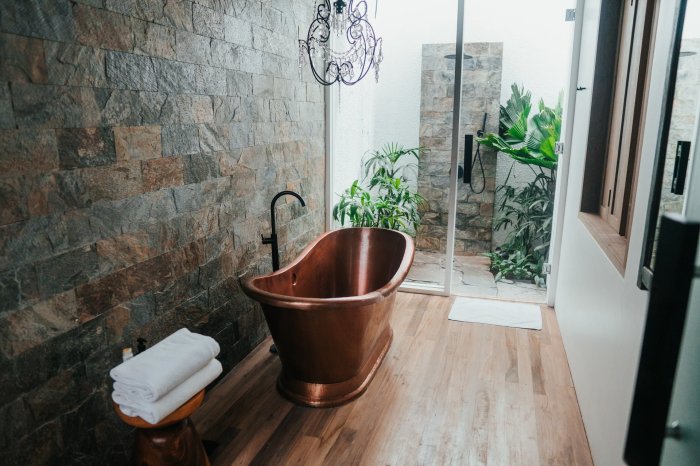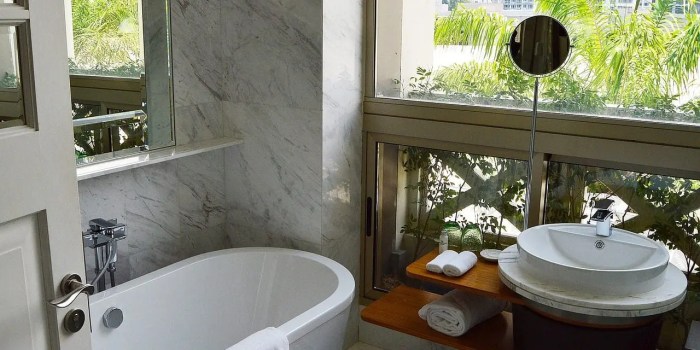Bathrooms are often overlooked when it comes to eco-friendly renovations, but they offer a great opportunity to reduce your environmental impact and create a more sustainable home. By incorporating eco-friendly materials, fixtures, and design elements, you can create a bathroom that is both stylish and environmentally conscious.
In this article, we will explore a range of eco-friendly bathroom renovation ideas, from sustainable materials to energy-efficient lighting. We will also provide tips on how to incorporate natural ventilation and green design elements into your bathroom, and discuss the importance of sustainable practices during the renovation process.
Sustainable Materials
Incorporating sustainable materials into your bathroom renovation is a crucial step towards creating an eco-friendly space. These materials not only reduce your environmental impact but also enhance the durability and longevity of your bathroom.
When selecting eco-friendly materials, consider their environmental benefits, such as recyclability, low embodied energy, and reduced emissions. Additionally, pay attention to their durability and lifespan to ensure they can withstand the demands of a bathroom environment.
Recycled Materials
- Recycled glass: Countertops, tiles, and shower enclosures made from recycled glass reduce waste and conserve natural resources.
- Recycled plastic: Shower curtains, bath mats, and storage containers made from recycled plastic help divert waste from landfills.
- Recycled metal: Faucets, showerheads, and hardware made from recycled metal conserve energy and reduce greenhouse gas emissions.
Low-VOC Materials
- Low-VOC paints: Paints with low volatile organic compounds (VOCs) emit fewer harmful chemicals into the air, improving indoor air quality.
- Low-VOC adhesives: Adhesives with low VOCs reduce the release of toxic fumes, creating a healthier environment.
- Low-VOC sealants: Sealants with low VOCs prevent moisture damage while minimizing air pollution.
Sustainable Wood
- FSC-certified wood: Wood certified by the Forest Stewardship Council (FSC) comes from responsibly managed forests, promoting sustainable forestry practices.
- Bamboo: A rapidly renewable resource, bamboo is an eco-friendly alternative to traditional wood.
- Cork: Cork is a natural, renewable material with excellent insulating properties.
Natural Stone
- Marble: A classic and durable natural stone, marble adds a touch of luxury while being relatively easy to maintain.
- Granite: Known for its exceptional durability and heat resistance, granite is an ideal choice for countertops and vanity tops.
- Slate: A versatile natural stone, slate can be used for flooring, walls, and showers, providing a unique and earthy aesthetic.
Water-Efficient Fixtures
Water conservation is a crucial consideration in bathroom renovations. By implementing water-efficient fixtures, you can significantly reduce your water consumption, benefiting both the environment and your wallet.
One of the most effective ways to save water is by installing low-flow toilets. Traditional toilets use an average of 1.6 gallons per flush, while low-flow models use only 1.28 gallons or less. This seemingly small difference can result in substantial water savings over time.
For example, a family of four can save up to 20,000 gallons of water per year by switching to low-flow toilets.
Another way to conserve water in the bathroom is by using low-flow showerheads. Traditional showerheads use an average of 2.5 gallons per minute, while low-flow models use only 1.5 gallons per minute or less. This can result in significant water savings, especially for households with multiple bathrooms or frequent showers.
The cost-saving benefits of installing water-efficient fixtures are also worth considering. By reducing your water consumption, you can lower your water bills and contribute to a more sustainable lifestyle.
Cost-Saving Benefits
- Lower water bills
- Reduced environmental impact
- Potential tax incentives and rebates
Energy-Efficient Lighting
Upgrading your bathroom’s lighting with energy-efficient options not only enhances the ambiance but also significantly reduces your carbon footprint. These eco-friendly lighting solutions offer numerous advantages, including:
- Reduced energy consumption
- Lower utility bills
- Extended lifespan, reducing waste
- Improved indoor air quality by reducing heat emission
LED Bulbs
LED (Light-Emitting Diode) bulbs are a popular choice for eco-friendly bathroom lighting. They consume up to 80% less energy than traditional incandescent bulbs and have a lifespan of up to 50,000 hours, significantly reducing replacement frequency.
Natural Lighting
Incorporating natural lighting into your bathroom design can further enhance energy efficiency. By maximizing natural light sources, you can reduce the reliance on artificial lighting during the day. Consider installing skylights, large windows, or frosted glass to allow ample sunlight to enter the space.
Impact on Carbon Emissions
The use of energy-efficient lighting in bathrooms has a positive impact on reducing carbon emissions. By reducing energy consumption, you contribute to lowering greenhouse gas emissions associated with electricity generation. This, in turn, helps mitigate climate change and promote a more sustainable future.
Natural Ventilation
Natural ventilation plays a crucial role in maintaining a healthy and comfortable bathroom environment. By allowing fresh air to circulate, it helps remove moisture, reduce odors, and prevent the growth of mold and mildew.To improve natural ventilation in bathrooms, consider incorporating design strategies such as:
Windows
- Installing windows that can be opened to allow fresh air in.
- Placing windows strategically to create cross-ventilation, which promotes airflow throughout the space.
Exhaust Fans
- Installing exhaust fans that are vented to the outside to remove excess moisture and odors.
- Choosing exhaust fans with a high CFM (cubic feet per minute) rating for optimal air extraction.
Natural ventilation not only improves air quality but also reduces the risk of mold and mildew growth. Mold thrives in moist environments, and by maintaining proper ventilation, you can prevent the buildup of moisture that fosters its growth.
Green Design Elements
Incorporating eco-friendly design elements in bathrooms enhances both aesthetics and sustainability. Natural elements like plants and stone add organic beauty and freshness, creating a serene and spa-like atmosphere.
Use of Recycled and Upcycled Materials
Repurposing and recycling materials in bathroom design reduces waste and promotes environmental consciousness. Upcycled wood, for instance, adds character and warmth to bathroom vanities and cabinetry. Recycled glass tiles create stunning mosaic patterns for showers and backsplashes, adding a touch of shimmer and texture.
Sustainable Practices
Sustainable practices during bathroom renovations are crucial for protecting the environment and ensuring the health and well-being of occupants.
Adopting eco-friendly practices can significantly reduce the environmental impact of renovations. By reducing waste, using non-toxic materials, and implementing energy-efficient measures, homeowners can contribute to a greener and healthier planet.
Waste Reduction
- Donate or sell old fixtures and materials instead of discarding them.
- Choose materials with high recycled content or that are sustainably sourced.
- Reduce packaging waste by purchasing products in bulk or choosing products with minimal packaging.
Non-Toxic Cleaning Products
- Use cleaning products made from natural ingredients that are non-toxic and biodegradable.
- Avoid harsh chemicals that can harm the environment and human health.
- Opt for products that are certified by reputable organizations like Green Seal or EcoLogo.
Impact on the Environment and Human Health
- Sustainable practices reduce greenhouse gas emissions and protect air and water quality.
- Non-toxic materials and cleaning products promote a healthier indoor environment, reducing exposure to harmful chemicals.
- Conserving resources and reducing waste contributes to a more sustainable future for generations to come.
Conclusion
By following these eco-friendly bathroom renovation ideas, you can create a beautiful and sustainable space that will reduce your environmental impact and improve your health and well-being. So what are you waiting for? Start planning your eco-friendly bathroom renovation today!



